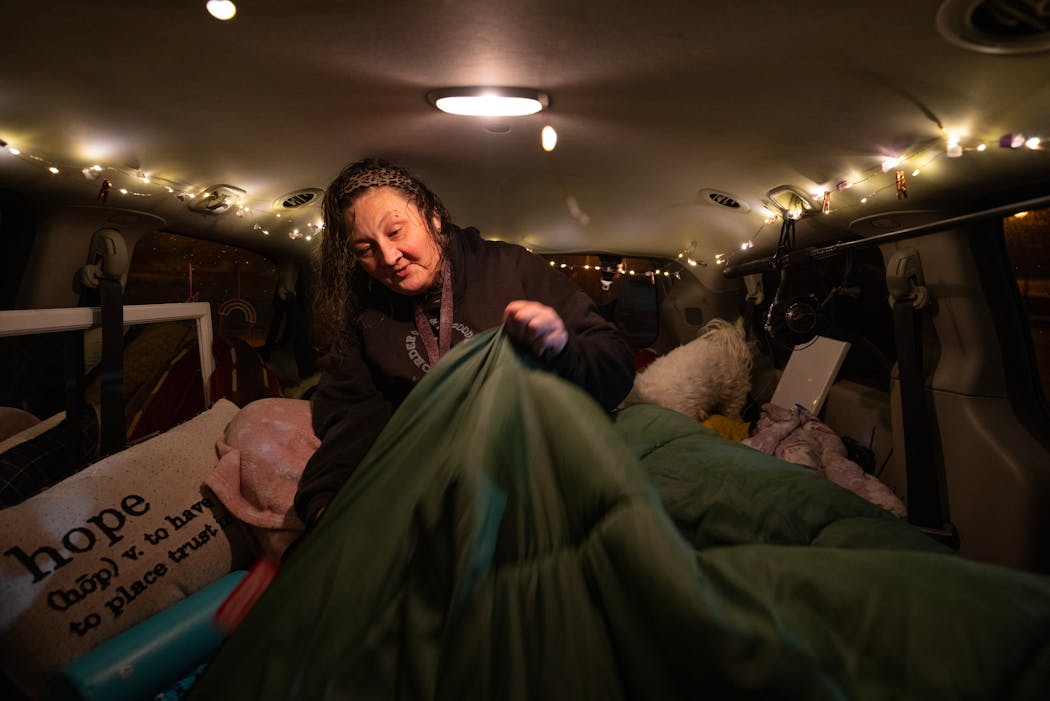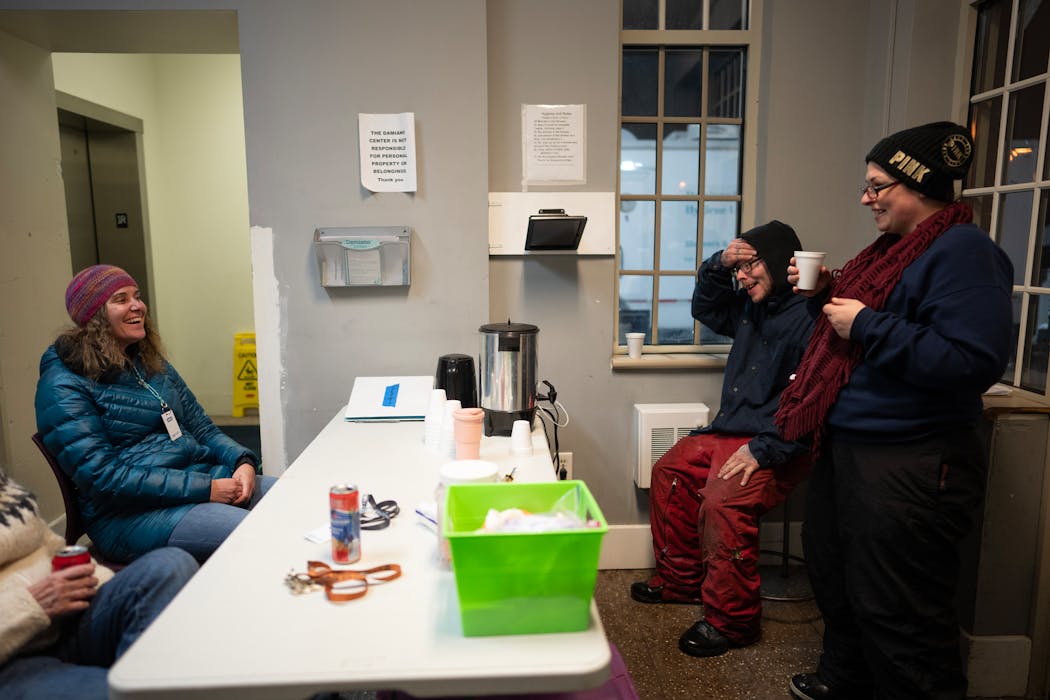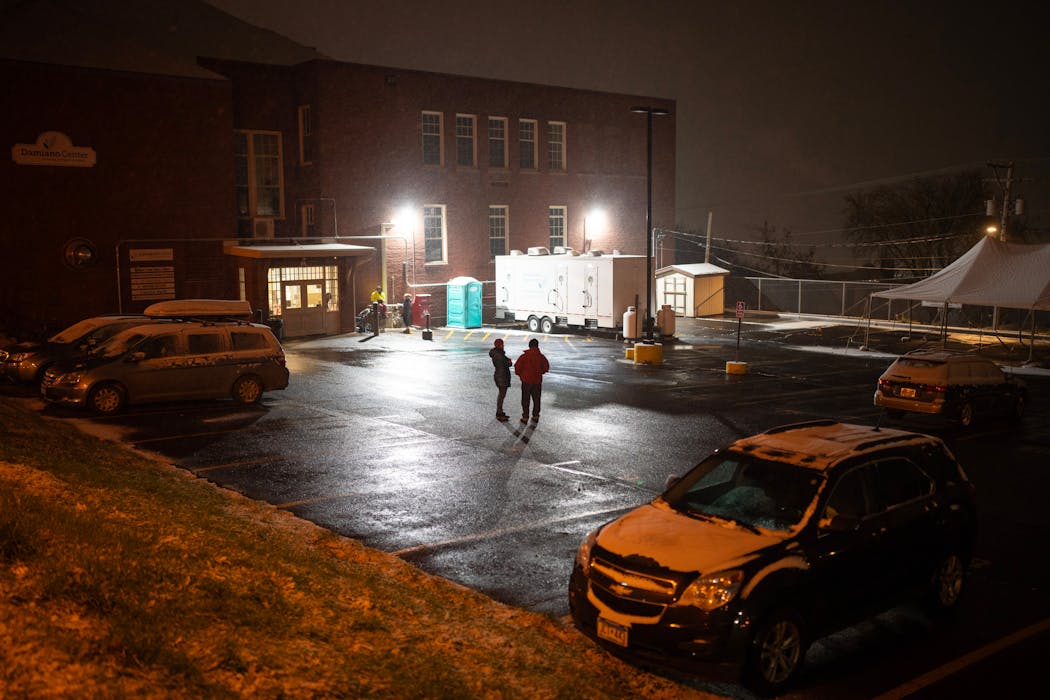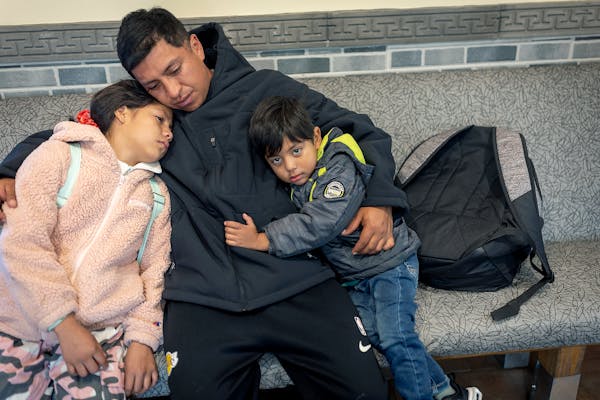DULUTH – Her hair still damp from the mobile shower, Lynette Ruse crossed a parking lot under briskly falling snow and opened the door to her home, a 2012 Dodge Caravan.
Inside, battery-powered lights twinkled as Ruse tended to her two tiny white dogs and lit incense sticks, a pre-bedtime ritual. All three burrowed into a makeshift bed where the backseats used to be.
They were parked in a brightly lighted lot in a run-down neighborhood. On this cold October night last week, occupants of six other vehicles in the lot settled into their nighttime routines. A hospital cafeteria worker spent the night in a Chevy Equinox. A 36-year-old with a debilitating illness went to sleep in an old RV without a working heater.
It was nearing 10 p.m., the start of the quiet period for Duluth's Safe Bay, and one of the last nights Ruse and the others would be allowed to park overnight. The new seasonal refuge for people living in their cars closed at the end of October, as the city's overnight warming shelter opened.
Ruse's minivan is not only her home, it's her workplace. Ruse, 51, delivers food for DoorDash. She said she doesn't consider herself homeless. "Houseless" is how she describes it.
"I got my system, and I've got it down," Ruse said about her adaptation to living in her minivan. "I'm proud of being able to at least carve this out."
The Safe Bay program stems from Stepping On Up, a coalition of Duluth organizations taking on chronic homelessness amid an enduring affordable-housing shortage. Nearly 600 people used Duluth's seasonal overnight warming shelter last winter, a place that offers mats for sleeping but not privacy. The city of about 87,000 has fewer than 200 shelter beds, and they are always full.
With counterparts across the country, Safe Bay uses the parking lot of the Damiano Center, which houses nearly 20 programs, including a soup kitchen, a free store, a mobile hygiene unit and secure storage for unsheltered people. Registered guests can park from 8 p.m. to 8 a.m.
Around 200 people, including children, have stayed in Safe Bay since its April opening. They prefer the dignity and autonomy that comes with private space, even if it's a car. It's been home to families in difficult situations, people who have lost jobs, recent arrivals from other cities, the chronically homeless. Some have stayed for weeks.
About half had never taken advantage of any resources for the homeless. Many have jobs.
"A lot of these folks have never experienced this before in their entire life," said Anne Romberg, a Safe Bay staff member. And they sink to the bottom of a hundreds-deep housing assistance waiting list, she said.
"They're in shock that they're in this situation," she said, "and you can really see how frustrating it is."
A path to housing
Emergency options such as Safe Bay and a 24-hour "triage shelter" expected to be built next year are part of a larger plan, said Joel Kilgour, coordinator of the effort.
The triage shelter, equipped with supportive services, will likely replace the outdoor seasonal village plan announced in 2022, because real estate and staffing are hard to come by. Among other projects, the Stepping On Up coalition hopes to build 200 permanent, low-cost, small-footprint homes.
The Chum shelter has applied for $16 million in newly approved state aid to reduce homelessness, and St. Louis County and the city are also investing in projects.
The city and county regularly field complaints about discarded needles, encampments, public urination and property damage. So much of this relates to a lack of options, said John Cole, executive director of Chum.
If all these efforts are successful, the whole community benefits, he said: The number of encampments spread across the 26-mile-long city would decrease, but more importantly, people would have a better chance to rebuild their lives.
A 'godsend'
Safe Bay guests had access to showers, gas cards, internet, supportive services, charging stations, toiletries, towels and meals served by the Damiano Center.
The six showers allowed guests to be presentable for work or job interviews.
At its peak, the parking lot played host to about two dozen vehicles, well below its capacity of 50. As the nights grew colder, numbers dwindled. The staff kept the lot safe with surveillance cameras and on-site workers stationed inside the building's entrance where guests often gathered for coffee when they sign in. From time to time, these workers walked around the lot. Intruders were scarce.
One guest wept at the relief she felt having a safe space to sleep, said Seth Currier, executive director of the Damiano Center. She had tried sleeping in the parking lot of Walmart or other lots where activity continues throughout the night, but was too afraid. That's a common problem, along with people calling the police if they see someone sleeping in a car on a residential street, which is legal. People sometimes drive great distances to sleep in more remote areas, using up precious gasoline.
Erik Lind, 54, stayed in the lot for a month while looking for a room to rent. He learned about it by searching the internet, after letting go of his Duluth apartment in September to travel west. When he returned, he couldn't find anything he could afford.
Lind was rehired at his old job delivering meals to patients at Essentia Health's St. Mary's Medical Center, but the $19.68 he earns per hour isn't a match for the city's tight rental market.
Last week, his legs were swollen because he can't fully stretch out in the reclined passenger seat of his small SUV overnight. His face was lined with exhaustion from little sleep, and his feet were cold from being covered by a single blanket. He warms up in a restroom or running his car for a bit, if he has enough fuel.
Nearly 20 guests have found permanent housing during their stays. Homeless since their trailer park closed, Sebastian Sieler and his fiancee stayed at Safe Bay since April, calling it a "godsend." While in recovery for drug use, Sieler spent two years living in an RV, kicked out of lot after lot and racking up parking tickets. But the countdown to a brick and mortar home is on: In two weeks, they get the keys to a Lincoln Park apartment.
Ruse used to be a married homeowner, but she was divorced and moved into an apartment in Superior, Wis. She lost her apartment several months ago after her landlord became sick and sold his properties. She's been in her van ever since.
She misses cooking and gardening, but appreciates the camaraderie formed in the lot over the summer. Folks gathered with lawn chairs to grill, and helped each other fix their cars or find something to eat. Ruse knows she will remain close to the friends she made.
Ruse will live like a nomad through the winter or stay with her adult children in a pinch. She doesn't want to take the spot at the warming shelter of someone who doesn't have a vehicle, unless hers breaks down. Her 21-year-old son used to share the van with her, but she was able to help him secure his own place recently.
Her biggest worry is her aging minivan, with its 167,000 miles. One problem could eat up her income, she said, already necessary for medications and other health care. She will stay in Duluth to work and be near her kids, thrilled that they are doing well.
"Now, I am just figuring myself out," she said.
With the end of Safe Bay services, she loses routine, she loses security. She and her dogs spent the past few nights sleeping in a quiet place near the St. Louis River, but she'll move frequently among other remote neighborhoods, parking late and waking early, hoping to go unnoticed.

GOP endorses Tad Jude for congressional seat Dean Phillips is leaving
One day in the frantic life of a Children's Minnesota emergency room nurse
Sen. Nicole Mitchell off committee assignments while case under review






